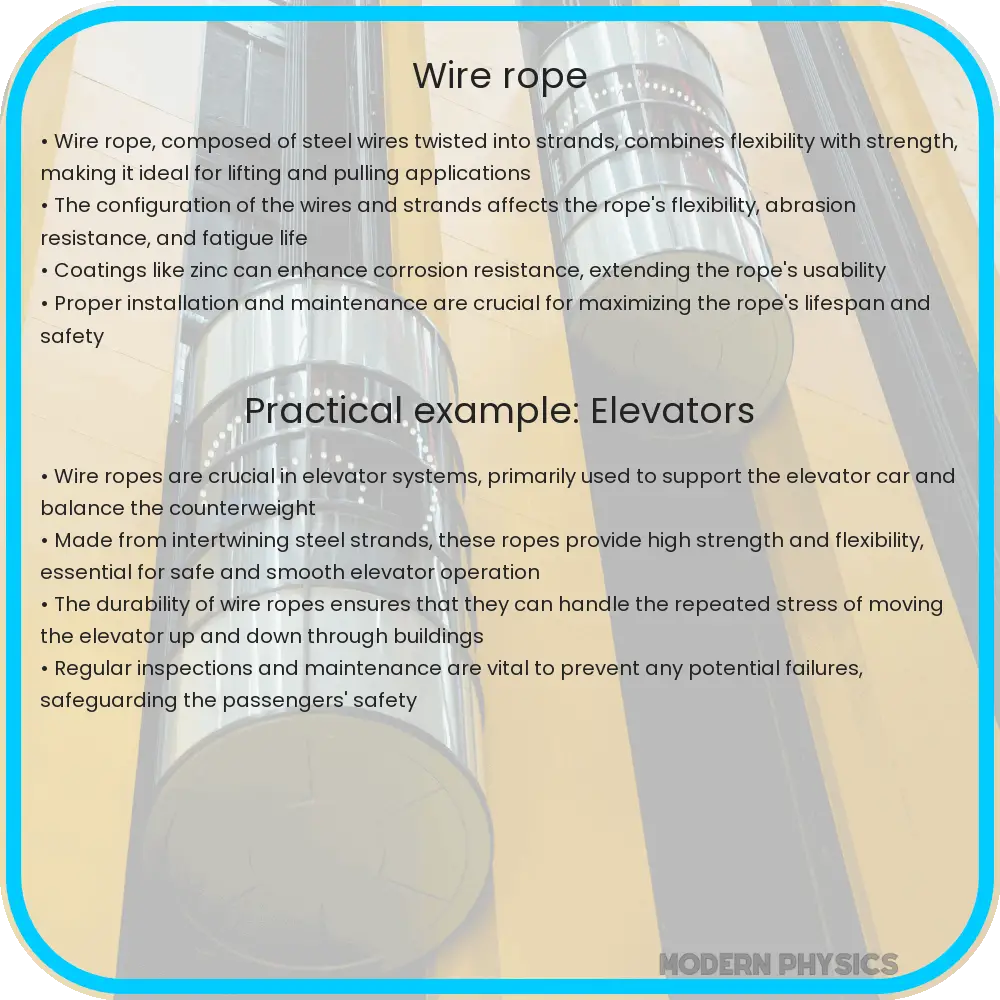Explore the strength, durability, and applications of wire rope in this comprehensive guide, covering composition, maintenance, and safety tips.

Understanding Wire Rope: Composition and Characteristics
Wire rope is an essential component in various industrial, construction, and marine applications. Known for its strength and durability, wire rope is designed to withstand challenging conditions and heavy loads. The composition of wire rope plays a significant role in its properties and suitability for specific applications.
Composition of Wire Rope
Wire rope is typically made from steel wires that are twisted into strands and then helically wound around a core. The core can be made of fiber (such as sisal), independent wire rope (IWRC), or polymer. The number of wires, strands, and the lay of the rope (the direction and manner in which the strands are twisted) determine the rope’s flexibility, abrasion resistance, and strength.
Strength and Load-Bearing Capacity
The strength of wire rope is primarily determined by the material composition and construction pattern. High-carbon steel, often alloyed with elements like chromium, nickel, or molybdenum, is commonly used for its high tensile strength and resistance to wear. The load-bearing capacity of wire rope is indicated by its breaking strength, which is the maximum tension it can withstand without failing. This capacity is crucial in applications like lifting heavy loads in construction and rigging in marine environments.
Durability and Corrosion Resistance
Durability is another critical aspect of wire rope, influenced by both material and construction. Protective coatings, such as galvanization (applying a protective zinc coating) or plastic coating, enhance corrosion resistance, especially in harsh environmental conditions. Additionally, lubrication plays a vital role in maintaining the rope’s integrity by reducing internal friction and wear.
Static Applications of Wire Rope
In static applications, wire rope is used where little to no movement is involved. Examples include guy wires for stabilizing structures, cables for suspension bridges, or as architectural elements. In these applications, the emphasis is on the rope’s ability to resist environmental factors, such as temperature fluctuations and corrosive elements, while maintaining its structural integrity over time.
Understanding the composition, strength, durability, and specific applications of wire rope is crucial for selecting the right type for a particular use. Its ability to perform under stress, resist wear, and withstand environmental challenges makes it a reliable choice in various sectors.
Optimizing Wire Rope Performance
To maximize the performance and lifespan of wire rope, several factors need to be considered. Regular inspection and maintenance are paramount to identify any signs of wear, corrosion, or damage. This involves checking for broken wires, abrasions, rust, and deformations. Proper handling and storage also contribute significantly to the rope’s durability. Avoiding kinks, sharp bends, and exposure to corrosive substances helps in maintaining the rope’s structural integrity.
Choosing the Right Wire Rope
Selecting the appropriate wire rope for a specific application requires a thorough understanding of the operational requirements. Factors such as the type of load (static or dynamic), environmental conditions, bending flexibility, and abrasion resistance need to be considered. Consulting with manufacturers and experts can provide valuable insights into the most suitable wire rope type, taking into account factors like diameter, construction type, core type, and lay direction.
Advancements in Wire Rope Technology
Advancements in materials science and engineering have led to the development of wire ropes with improved characteristics. High-performance materials like stainless steel offer enhanced corrosion resistance and strength. Innovations in manufacturing techniques have also resulted in ropes with greater flexibility, higher fatigue resistance, and improved wear characteristics, making them suitable for more demanding applications.
Safety Considerations
Safety is a critical aspect when working with wire rope. Ensuring that the rope is not overloaded beyond its breaking strength is crucial to prevent accidents. Proper training in handling and installation techniques is essential for personnel involved in operations involving wire ropes.
Conclusion
Wire rope is a versatile and robust component widely used in various industries due to its exceptional strength, durability, and reliability. Understanding its composition, properties, and maintenance requirements is essential for optimal performance and safety. With the right selection and care, wire rope can significantly contribute to the efficiency and safety of operations in construction, marine, and other industrial applications. As technology advances, we can expect even more innovative solutions in wire rope design and application, further broadening its range of uses and effectiveness.
